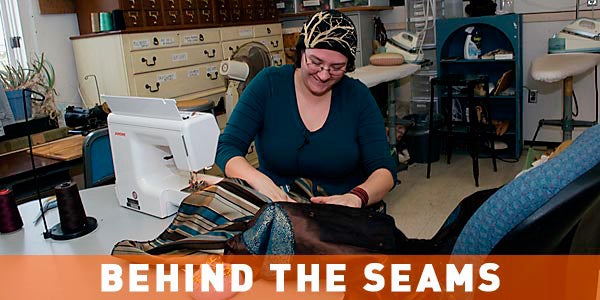Behind the Seams

Who makes the costumes?
Costume shop manager Sally Tschantz-Dwyer oversees the production—construction, alteration, and finish work—of all the costumes. Sally works extremely hard to get the details right and makes my job a little less stressful. We hire a professional seamstress and have a staff of students, ranging from experienced costume design majors to students who work for credit. And for a big show, that is A LOT of work, since no piece of clothing is ever exactly the right size.
Is there research involved in designing costumes?
There’s always research. I look at historical sources, period garments, and even written accounts. We research fabrics, construction techniques—everything that can make our production as authentic as possible. Even contemporary shows require a great deal of work.
How many costumes have been created during your 10-year stint?
Close to 1,000 pieces—we never really count. A show like Little Women had 100 or so costumes, whereas a show like Fat Pig only had a dozen.
How does the design process begin?
Generally, the process starts with meetings and conversations with the director. We discuss character and place, style, and historical needs. Then I will bring either research or sketches for further discussion. After discussing options and changes, I will do renderings of what we want the final costumes to look like, with fabric swatches and construction ideas. When I’m designing a show (I do one or two a season) I do a great deal of sewing.
What are the challenges?
The biggest challenge is time—trying to create everything.
What happens to the costumes when the play ends?
We save them and use them for support characters for other productions. They are stored in three areas in the Fine Arts Center, which hold hundreds of thousands of costumes and play items that were bought or created during the past 45 years. Reciprocal agreements with other theaters allow them to use our items and vice versa. Every couple of years, we clean out some of the stock and donate the pieces to high schools and other theaters.
Do you ever buy ready-mades or buy from vintage stores?
Vintage clothes are generally too delicate to be used in productions—12 performances can take a toll—but we have used them for reference and for patterns. There have been a few that have made their way onstage. Clothing for contemporary shows is almost always purchased. I have also purchased contemporary items for period shows—things that are similar to past looks.
What kind of costume is the most difficult to create?
Every costume is hard. It has to reflect character, time, place, the actor’s needs, the director’s needs, shop ability, budget, and time constraints. The list goes on. But every once in awhile there is a sense of satisfaction that a particular costume is appropriate and just right.
What was your favorite creation?
I love and hate everything I have made.
— By Jan Wenzel ’87
Photo By Michael Salerno
 Home
Home Browse
Browse Close
Close Events
Events Maps
Maps Email
Email Brightspace
Brightspace eCampus
eCampus


